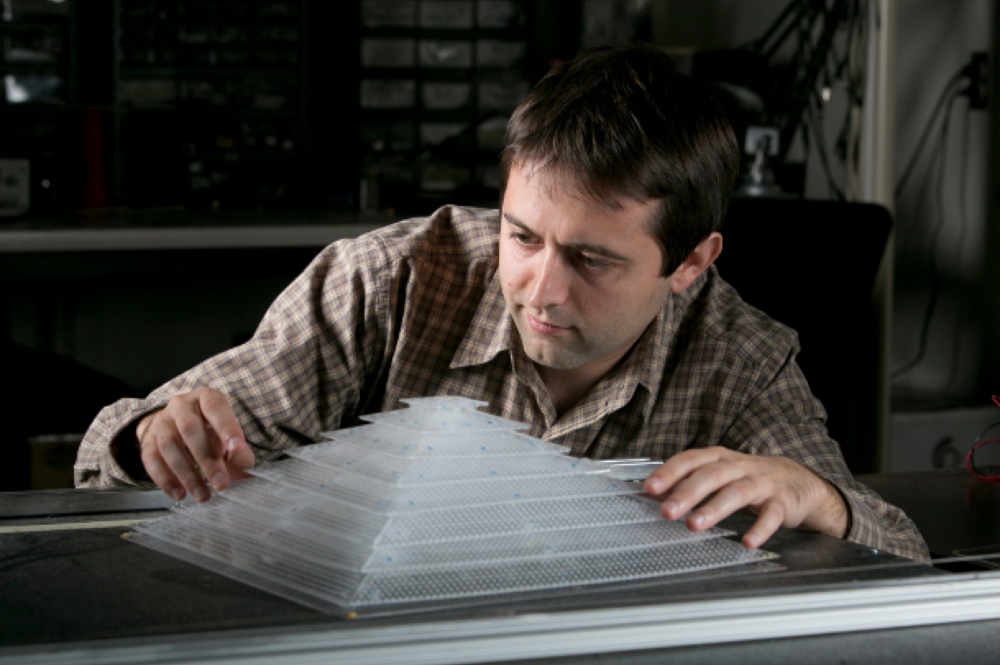'Invisibility' Cloak May Hide Things from Sonar

Cloaking devices, a staple of science fiction (think Harry Potter), are getting closer to reality. Researchers at Duke University have built a structure that would hide anything under it from sonar — at least in air.
Made of sheets of perforated plastic, the pyramid-shaped cloak changes the shape and speed of sound waves as they hit it. Those changes make the sound waves appear to reflect off the surface the pyramid is standing on, as though it wasn't there.
To build the cloak, Lucian Zigoneanu, Bogdan-Ioan Popa and Steven Cummer modeled the way sound waves act on a computer. They tried several simulated shapes, and eventually came up with the pyramid design, made with sheets that have holes in them. [See Video of Sound-Cloaking Device in Action]
Holes are key
To test their idea, they put a sphere inside the pyramid, and then placed both in a largely empty room with a sound generator and a microphone. The sound generator made a "ping" that would bounce off the pyramid. A single microphone on a gantry-like apparatus recorded the sound from hundreds of different positions.
The holes had to be exactly the right size, adjusted according to the wavelength of the sound hitting them. Without the holes the sound waves would just bounce off and reveal the presence of the pyramid. With them, some sound waves were slowed down. The slower waves followed a longer path back to a detector, just as they would if the pyramid wasn't there. The shape of the reflected wave looks just as it would if it hit a flat surface, fooling any sonar into thinking the cloak and anything under it doesn't exist.
When sonar equipment sends a "ping," or bats or dolphins use echolocation, they time the sound to see how long before it is reflected back. Simply absorbing the sound wouldn't work for the same reason absorbing all light wavelengths wouldn't — instead of an invisible object you'd have a black shape.
Sign up for the Live Science daily newsletter now
Get the world’s most fascinating discoveries delivered straight to your inbox.
"In [the] cloaking problem you can't have the sound reflect in a different direction, and you can't just absorb, because it casts a shadow," Cummer told Live Science.
That fact makes cloaks tricky to design: The waves of sound or light must come back to the detection device — be it sonar microphones, human eyeballs or radar — with the same shape and frequency they'd have with no object in the way.
Next steps for sonar cloak
Cummer noted that there's still some way to go before this technology would be ready to protect a submarine.
"The real kicker in trying to transition to water is that there's so much contrast in the material," he said. "With air and a solid, no sound wave energy gets into the solid."
Unlike air, water, is so dense that the vibrations get into the cloak itself and the object you want to hide. The density of water also varies more, so the waves behave differently and a much more involved set of calculations would be required. In addition, a moving object adds another layer of complexity to the design, because the angle the sound waves are coming from changes.
That said, there are other areas where a sound cloak might prove useful. Auditorium design is one, and solving the problems of projecting sounds loud enough for the people in the cheap seats to hear while avoiding unwanted echoes. Cloaking certain structures might one day solve those problems.
Cummer, a professor of electrical and computer engineering, started his scientific career investigating light waves, but soon branched into investigating sound as well. "Waves are waves," he said.
With this line of research he wanted to show that using computer-aided design and applying sophisticated mathematics could allow one to build cloaks without exotic materials. "We wanted to more broadly show that transformation-based approach can be done with well designed things not that hard to make," he said.
The sound cloak is detailed in the March 9 issue of the journal Nature Materials.
Follow LiveScience on Twitter @livescience, Facebook & Google+. Original article on Live Science.










